[Back to the First Page]
[Research Group's Publications]
[Members of the Research Group]
[>>>]

TEAMS
Thermal Energy Atom and Molecular Scattering
(Dr. D. Farías, M. Patting, F. John)
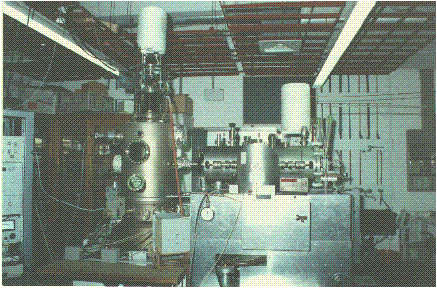
Research Fields
Diffraction of low energy He- and Ne-beams
(20 - 150 meV) is an absolutely nondestructive
technique, sensitive to the topmost surface layer
only. It is applicable to metals, semiconductors,
and insulators and has a unique sensitivity to
hydrogen adsorbed on surfaces. Our efforts
concern quantitative determinations of the
surface corrugation of regular adsorbate systems
(especially hydrogen) as well as (adsorbate
induced) surface reconstructions. Calculation
methods for diffraction intensities with realistic
particle-surface interaction potentials are further
developed. A recent scientific highlight
concerns the experimental proof of
anticorrugating effects with He and their
absence with Ne. Future
research plans include quantitative aspects of
rotational excitations and de-excitations upon
diffraction of molecular hydrogen and
deuterium.
The Helium-Diffraction Apparatus
Beam System
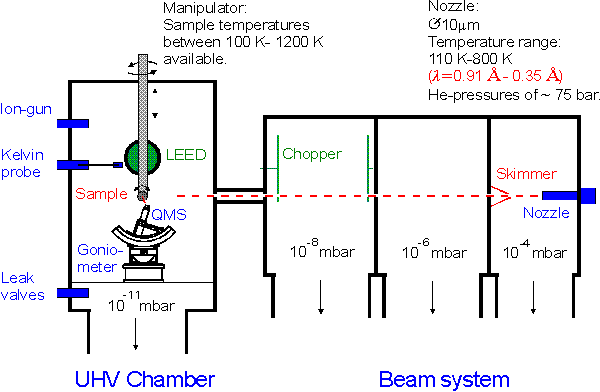 The experiments have been carried out in the
UHV-apparatus shown schematically in
the figure.
The experiments have been carried out in the
UHV-apparatus shown schematically in
the figure.
It is equipped with standard LEED and
ion gun systems to characterize and clean the surface, in addition to a
Kelvin probe for performing work function measurements and a quadrupole mass
spectrometer with
an axial-beam ion source for recording thermal desorption spectra.
The base pressure in the chamber was typically
3 x 10-11 mbar, reaching 5 x 10-10 mbar
with the He beam on.
The crystal is mounted on a standard manipulator,
modified to allow azimuthal rotation of the sample as well as heating to
1200 K and cooling to 100 K.
Scattering Geometry
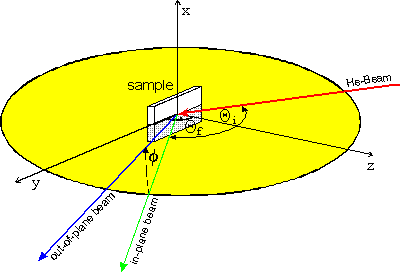 The angular distribution of the back-scattered atoms was analyzed
with a quadrupole mass spectrometer mounted on a
two-axis goniometer.
This arrangement allows rotations of 200° in the scattering plane,
defined by the beam direction and the normal to the surface,
as well as ±15°
normal to the scattering plane.
The angular distribution of the back-scattered atoms was analyzed
with a quadrupole mass spectrometer mounted on a
two-axis goniometer.
This arrangement allows rotations of 200° in the scattering plane,
defined by the beam direction and the normal to the surface,
as well as ±15°
normal to the scattering plane.
Rotation of the goniometer and data aquisition
are performed simultaneously by a computer program; one scan takes
about 2 minutes. As it will become apparent,
the ability to measure out-of-plane spectra is a valuable asset in
interpreting diffraction data. The
scattering geometry
is schematically represented in the figure on the left.
Angles of incidence and angles of scattered beams
are both
referenced to the surface normal, whereas the out-of-plane angle
is measured from the scattering plane.
Some Results
Anticorrugating Effects
As an experimental example of anticorrugating effects see the figure below including
sphere models of Ni(110)c(2x4)H and Rh(110)(1x2)H together with grey scale
representations of the corrugation functions derived from He and Ne diffraction.
In the sphere models open large circles denote metal atoms and full small circles H adatoms
at the locations determined by LEED. The areas of the corrugations correspond to
those of the sphere models. The H atoms have the largest corrugation amplitudes
and thus show up as the brightest spots in the grey scale top views. Note that in all
He-derived corrugations there occur less bright maxima between the H atoms along [001]
(perpendicular to H atom rows) on all H-free metal rows in disagreement with
the true atom arrangements shown in
the sphere models. In contrast to this, in the Ne-derived corrugations the metal maxima
are shifted by a/2 along [1-10] (parallel to H atom row)
in agreement with the true surface structures.
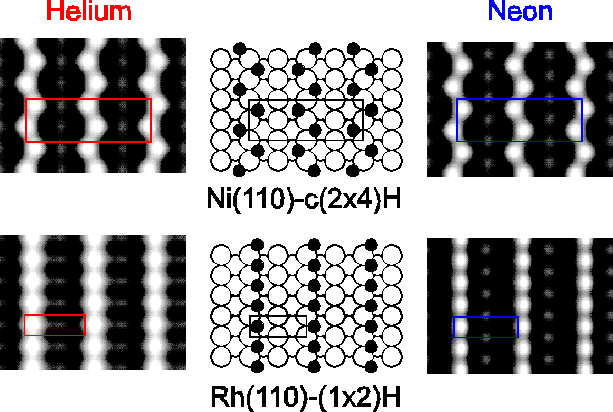
For a detailed description about anticorrugating effects see:
[K.H. Rieder, G. Parschau, B.
Burg: Phys. Rev. Lett. 71, 1059 (1993)] and the references inside.
Open Metal Surfaces: fcc(311)
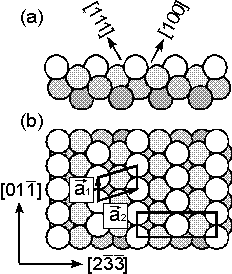 Besides fcc(110,111,100) metal surfaces more open high index fcc(311) surfaces
are at the focus of present interest. A special property
of the fcc(311) surfaces is the existence of both (111) and (100) microfacets
offering a large
variety of adsorption sites. The figure on the right shows side (a) and top (b) views
of the fcc(311) sphere model.
The rectangular and primitive unit cells are indicated.
Note the asymmetrical surface structure and the
possible adsorption sites in the first and second layer and their coordination
(top, brigde, threefold, fourfold).
Besides fcc(110,111,100) metal surfaces more open high index fcc(311) surfaces
are at the focus of present interest. A special property
of the fcc(311) surfaces is the existence of both (111) and (100) microfacets
offering a large
variety of adsorption sites. The figure on the right shows side (a) and top (b) views
of the fcc(311) sphere model.
The rectangular and primitive unit cells are indicated.
Note the asymmetrical surface structure and the
possible adsorption sites in the first and second layer and their coordination
(top, brigde, threefold, fourfold).
With He and Ne diffraction we investigated
the clean and adsorbate covered surfaces of Ni(311), Rh(311) and Pd(311).
We observed the formation of several ordered
adsorbate structures with hydrogen and oxygen depending on temperature and coverage,
also in combination
with the HREELS method. Examples of individual results can be found
in the publication list [Ni(311),
Rh(311),
Pd(311)].
Contact:
farias@physik.fu-berlin.de
[Back to the First Page]
[Research Group's Publications]
[Members of the Research Group]
[<<<]



 The experiments have been carried out in the
UHV-apparatus shown schematically in
the figure.
The experiments have been carried out in the
UHV-apparatus shown schematically in
the figure. The angular distribution of the back-scattered atoms was analyzed
with a quadrupole mass spectrometer mounted on a
two-axis goniometer.
This arrangement allows rotations of 200° in the scattering plane,
defined by the beam direction and the normal to the surface,
as well as ±15°
normal to the scattering plane.
The angular distribution of the back-scattered atoms was analyzed
with a quadrupole mass spectrometer mounted on a
two-axis goniometer.
This arrangement allows rotations of 200° in the scattering plane,
defined by the beam direction and the normal to the surface,
as well as ±15°
normal to the scattering plane.

 Besides fcc(110,111,100) metal surfaces more open high index fcc(311) surfaces
are at the focus of present interest. A special property
of the fcc(311) surfaces is the existence of both (111) and (100) microfacets
offering a large
variety of adsorption sites. The figure on the right shows side (a) and top (b) views
of the fcc(311) sphere model.
The rectangular and primitive unit cells are indicated.
Note the asymmetrical surface structure and the
possible adsorption sites in the first and second layer and their coordination
(top, brigde, threefold, fourfold).
Besides fcc(110,111,100) metal surfaces more open high index fcc(311) surfaces
are at the focus of present interest. A special property
of the fcc(311) surfaces is the existence of both (111) and (100) microfacets
offering a large
variety of adsorption sites. The figure on the right shows side (a) and top (b) views
of the fcc(311) sphere model.
The rectangular and primitive unit cells are indicated.
Note the asymmetrical surface structure and the
possible adsorption sites in the first and second layer and their coordination
(top, brigde, threefold, fourfold).